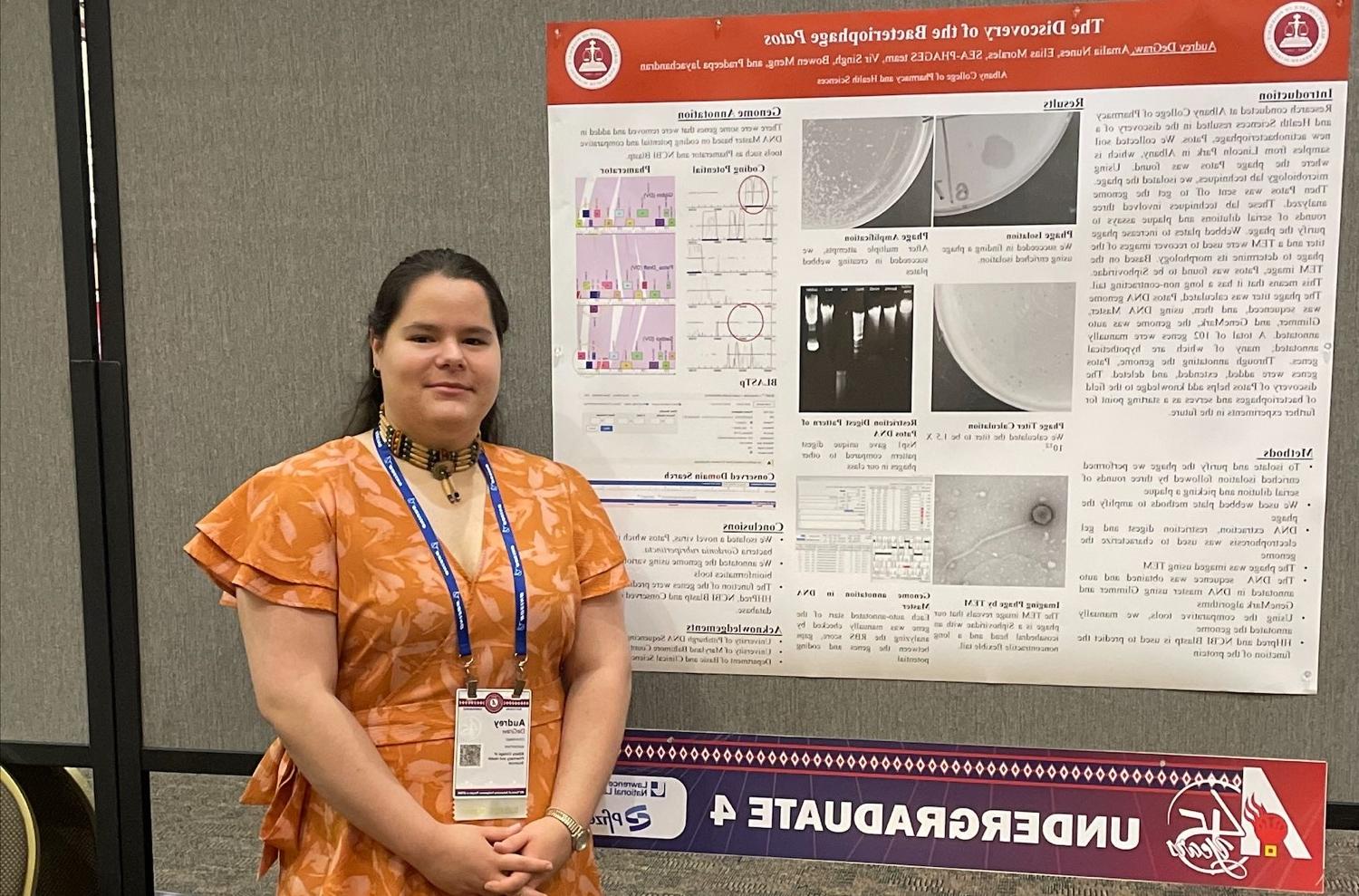
虽然18岁的奥黛丽·德格劳的祖父是奥农达加民族的一员, 上周,这位ACPHS大二学生去了一趟加州,找到了她的部落.
实现这一目标还需要一个真正的科学发现——在奥尔巴尼林肯公园的土壤样本中发现了一种新型病毒.
DeGraw, a microbiology student, 参加了在棕榈泉举行的美国印第安人科学与工程学会(AISES)全国会议, Calif., 她展示了一张海报,详细介绍了她与同学阿玛利亚·努涅斯和伊莱亚斯·莫拉莱斯进行的研究. The opportunity came about through DeGraw’s participation in the SEA-PHAGES program 以及她长期以来对参加AISES会议的兴趣.
There are two threads to DeGraw’s story, both involving genetics. 一个是全球十大赌博靠谱的平台一个微小的、无处不在的有机体的基因组排序. 另一种是源于德格劳自身基因密码的一种根深蒂固的欲望.
First, the academics.
DeGraw, 努涅斯和莫拉莱斯是第一批参加ACPHS SEA-PHAGES项目的新生, 由助理教授Pradeepa Jayachandran和实验室讲师Bowen Meng指导. The program, developed by the Howard Hughes Medical Institute, 旨在让一年级学生进行专业水平的科学研究——值得在全国会议上发表.
Through the program, 学生们收集土壤样本,并在其中寻找噬菌体——一种影响细菌的病毒,就像DeGraw和她的团队发现的那样. SEA-PHAGES代表科学教育联盟-噬菌体猎人推进基因组学和进化科学.
ACPHS团队学会了通过连续稀释和挑选菌斑来分离和纯化噬菌体. 然后他们用蹼板法扩增噬菌体,然后提取DNA. 在获得DNA序列后,他们使用各种信息学工具对基因组进行注释.
这个项目适合大一新生,因为学生不需要接受处理病原体所需的高级培训, Jayachandran said. 他们处理的细菌和病毒不会引起人类疾病.
The students named their newly found virus Patos, which means “ducks” in both Portuguese and Spanish, the heritages of Nunes and Morales, respectively. The name came from the ducks they saw in Washington Park, 那里的土壤没有林肯公园那么多细菌, where the bacteriophage was found. Nonetheless, they liked the association, 而且这个词在两种语言中都是一样的——所以华盛顿公园的鸭子得到了点头.
随后,Patos被编入一个国际放线菌噬菌体数据库. 该数据库将帮助科学家更多地了解这些古老物种的进化, ubiquitous organisms.
For a budding 18-year-old scientist, that’s thrilling.
“Genetics is just something that excites me,” said DeGraw, who described herself as naturally curious. “Any type of research really excites me. 我真的很喜欢动手的东西——我们在‘噬菌体’中学到的很多实验技术”——这是她和同学们对这门课的称呼.
更令人惊奇的是,噬菌体有可能被用于治疗抗生素耐药性疾病.
In one known case, 伦敦一名15岁的囊性纤维化患者患上了肺结核,他接受了一种被列入放线菌噬菌体数据库的噬菌体治疗, Jayachandran explained. 这种病毒的基因序列显示,它会攻击引起病人感染的细菌. 研究结果发表在2019年5月的《全球十大赌博靠谱的平台》杂志上.
Next, the heritage connection.
许多参加SEA-PHAGES的学生在专门为项目参与者举办的科学会议上展示他们的研究, Meng said. But DeGraw wanted something different. She knew about AISES through her aunt, 他是一位化学工程师,曾在AISES会议上发表过研究成果.
DeGraw’s sense of her indigenous heritage is deep, she said, inherited from her maternal grandfather, who was a member of the Onondaga Nation. 她戴着由当地工匠制作的珠宝,总是把她的头发——一种精神的代表——长长的或编成辫子. 她说,编辫子是有意为之的,是你一边编一边冥想的事情.
但是因为奥农达加人是母系的——亲属关系是通过母亲来定义的——DeGraw, her mother, and her aunt are not considered part of the tribe. By another controversial measure known as “blood quantum,” DeGraw is just one-quarter Native American.
德格劳矜持有礼,但她承认自己没有得到认可,这让她有点难过. As a researcher, 她很伤心,因为她没有比其他任何公众成员更多的机会获得奥内达加国家的资源.
“I’m still able to learn about my culture, but only what the Nation will let the public know,” she said. “I want to learn the Onondaga language, but I’m not allowed to.”
DeGraw在普拉斯基的奥斯威戈县的一个小村庄长大,除了自己的家庭,她几乎没有与土著文化有过什么联系, she said. She knew no other people of indigenous heritage. Now at ACPHS, she knows just a few others on campus.
For her, the AISES conference was, of course, 这是一个建立人脉,了解潜在实习经历或实验室的机会,她可能有一天会想在那里工作. 这也是她自己的人——土著遗产的科学研究人员——聚会的一部分.
Last week, as she was preparing to leave for the conference in Palm Springs, she was a little nervous. She has a long history of speaking in public, 回到她10岁时首次在县集市上展示蝴蝶的生命周期. But she had never presented to other scientists before. 她第一次坐飞机横穿全国也很担心.
然而,她显然也对这次会议的独特之处感到兴奋. Following her poster presentation, for example, 她会参加一个谈话圈——一个公开的谈话,她会分享她所学到的东西, in Native American fashion, rather than lecturing about it. 日程上有一场祈祷仪式,表演不同的部落舞蹈.
“This is a college and career fair, this is a STEM conference, but it’s also an indigenous conference,” she said. “这是我们聚在一起庆祝土著或第一民族的日子.”

